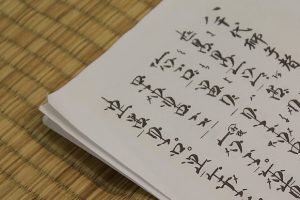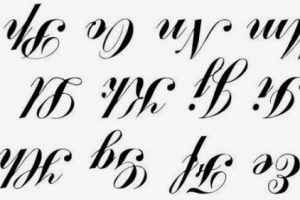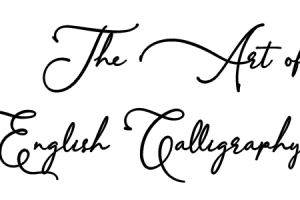Hindi Calligraphy is the art of writing Hindi alphabets in an elegant and beautiful way. It involves using various styles, techniques, and tools to create stunning pieces of art that not only convey the message but also leave a lasting impression on the viewer. Hindi calligraphy is a popular art form in India, and it has a rich history and cultural significance.
In this guide, we will take a closer look at the art of Hindi Calligraphy, its history, styles, tools, techniques, and tips to help you get started with this beautiful art form.
The History of Hindi Calligraphy
Hindi calligraphy has a long and rich history that dates back to ancient times. The earliest evidence of Hindi calligraphy can be traced back to the 4th century AD when Sanskrit was the dominant language in India. During this time, the art of writing in Sanskrit was highly valued, and calligraphers were respected members of society.
As Hindi started to gain popularity in India, calligraphers began to experiment with new styles and techniques to write the language in a more beautiful and elegant way. Over the years, several calligraphic styles have emerged in Hindi calligraphy, each with its unique characteristics and features.
The Styles of Hindi Calligraphy
There are several styles of Hindi calligraphy, each with its unique characteristics and features. Some of the popular styles include:
1. Devanagari Script: Devanagari is the most widely used script for writing Hindi, and it has a distinct calligraphic style that is easy to recognize. This style is characterized by its curved lines and rounded letters, and it is commonly used for official documents, newspapers, and books.
2. Modi Script: Modi script is an ancient script that was used to write several Indian languages, including Hindi. This style is characterized by its angular and sharp letters, which make it look more like a cursive script.
3. Kutila Script: Kutila script is an ancient script that was used to write Sanskrit and Prakrit languages. This style is characterized by its highly curved and fluid letters, which give it a more artistic look.
4. Lantsa Script: Lantsa script is a Tibetan script that was used to write several Indian languages, including Hindi. This style is characterized by its highly stylized and intricate letters, which make it look like a work of art.
The Tools and Techniques of Hindi Calligraphy
To create beautiful pieces of Hindi calligraphy, you will need some essential tools and techniques. Some of the essential tools include:
1. Calligraphy Pen: A calligraphy pen is a specialized pen that is used for creating beautiful calligraphy. It has a flexible nib that can be adjusted to create thick and thin lines.
2. Ink: High-quality ink is an essential component of Hindi calligraphy. It should be water-resistant, fade-resistant, and have good flow.
3. Paper: High-quality paper is also essential for creating beautiful calligraphy. It should be smooth, durable, and have good absorbency.
4. Ruler and Compass: A ruler and compass are essential for creating straight lines and perfect circles.
There are several techniques that you can use to create beautiful Hindi calligraphy. Some of the popular techniques include:
1. Brush Technique: Brush technique involves using a brush to create beautiful calligraphy. This technique is commonly used in Chinese and Japanese call
igraphy but can also be used in Hindi calligraphy. It involves holding the brush at a specific angle and using it to create thick and thin strokes.
2. Pointed Pen Technique: Pointed pen technique involves using a pointed pen to create beautiful calligraphy. This technique is commonly used in Western calligraphy but can also be used in Hindi calligraphy. It involves holding the pen at a specific angle and using it to create thin and thick strokes.
3. Blackletter Technique: Blackletter technique involves using a broad-nibbed pen to create calligraphy with thick and thin strokes. This technique is commonly used in European calligraphy but can also be used in Hindi calligraphy.
Tips for Creating Beautiful Hindi Calligraphy
Creating beautiful Hindi calligraphy requires practice, patience, and dedication. Here are some tips that can help you improve your skills:
1. Practice Regularly: Practice is the key to improving your skills in Hindi calligraphy. Set aside some time every day to practice, and gradually increase the difficulty level.
2. Choose the Right Tools: Choosing the right tools is essential for creating beautiful calligraphy. Invest in high-quality pens, ink, and paper to get the best results.
3. Study the Styles: Study the different styles of Hindi calligraphy and experiment with them to find the one that suits you the best.
4. Pay Attention to Detail: Pay attention to the details when creating Hindi calligraphy. Ensure that the lines are straight, the curves are smooth, and the strokes are consistent.
5. Experiment with Colors: Experiment with different colors to add more depth and interest to your calligraphy.
Conclusion
Hindi calligraphy is a beautiful and elegant art form that requires practice, patience, and dedication. By studying the history, styles, tools, and techniques of Hindi calligraphy and following the tips mentioned in this guide, you can create stunning pieces of art that will leave a lasting impression on the viewer. So, pick up your pens and start practicing Hindi calligraphy today!









Add Comment